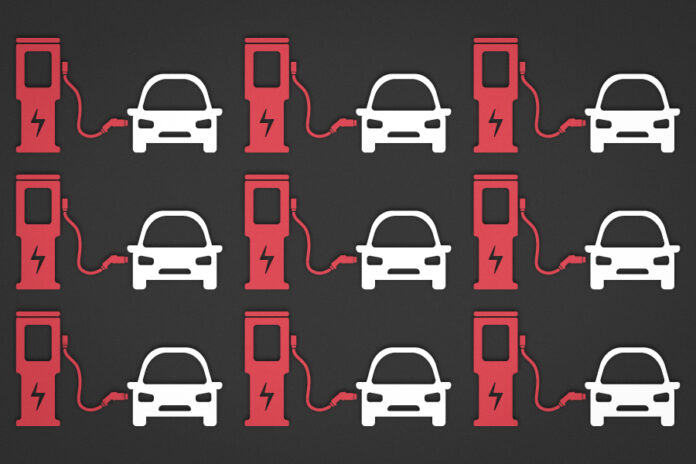Electric vehicle charger in Muir Commons example of rise in alternative energy
On Nov. 9, 2018, Muir Commons celebrated the installment of 26 Level-2 electric vehicle chargers, one for each household, as part of PG&E’s EV Charge Network program — making it the largest multi-unit dwelling electric car charging project in California thus far. Both UC Davis and Valley Clean Energy also plan on implementing more charging stations in parking lots and public places.
The EV Charge Network Program aims to “accelerate California’s transition to a clean transportation future by offering electric vehicle charger installation at select locations in PG&E’s service territory,” according to the PG&E website. The Muir Commons ad-hoc committee for EV charging related-services applied to the grant, which is specifically tailored to the implementation of chargers in workplaces and multi-unit dwellings such as apartment complexes.
Eugen Dunlap, a Muir Commons resident and committee member — along with members Ben Finkelor, Corey Bock and Laurie Friedman — spearheaded the movement for EV chargers. The initial estimate was around $700,000 in total, about $25,000 to $30,000 per household. The PG&E grant reduced the cost to $1,150 per household, and a grant from the Yolo-Solano Air Quality Management District’s Clean Air Funds Program lowered the final cost to $550, according to Dunlap, who noted the necessity of the grants to cover the costs of the technology.
“If you have a garage, you can put in a charger, but if you live in an apartment complex or something like that, you have a central parking lot and it gets very complicated and expensive,” Dunlap said.
Surprisingly, Dunlap is among only three residents out of the 26 who currently own an electric vehicle. According to the U.S. Department of Energy, electric vehicles can reach up to an average of 114 miles on a full battery, but many consumers are off-put by purchasing one due to range anxiety — the fear one’s car battery will run out before their destination — which the chargers may eliminate. However, all residents supported the cause, and the chargers opened up the possibility for residents’ next cars to be electric vehicles.
“The concept of range anxiety really isn’t as much of a problem as people think,” said Jim Parks, the director of customer care and marketing at Valley Clean Energy. “In other words, it’s not much of a real problem because people are mostly commuting and they have plenty of energy to do that with their electric vehicle, and the ability to charge at home.”
Level-2 chargers allow for more electricity to be delivered at a faster time as they are 240-volts, compared to the 120 volts of a Level-1 charger that most appliances are plugged into. The Level-2 chargers are maintained by PG&E and receive electricity from Valley Clean Energy Sources. The convenience of a Level-2 charger in combination with solar power helps incentivize an environmentally friendly form of transportation.
“For me, it was environmental because there [were] no tailpipe emissions, and it’s when you have solar cells on your roof you’re creating your own fuel,” Dunlap said. “I don’t have [an] oil well in my backyard — you probably don’t have one in your backyard. Even if we would have it, we still have to process the oil, so we’d have to have a refinery, and we don’t have that either. So, with solar, you’re producing your own electricity, and the electricity is in general cleaner than anything burning fossil fuels.”
Muir Commons has fostered a history of innovation, as it was the first new construction cohousing development in the United States when it was built in 1991. Additionally, the housing complex implemented its first electric vehicle charger 17 years ago and solar panels atop their Common Room several years ago, which was rare for residential areas.
“The Muir Commons installation is going to be [a] unique one in that there is one charger per home, and all of the homes do not have electric vehicles,” Parks said. “I think in the future, you’re going to see new homes built with chargers as a standard part of the package. It may, at some point, become a requirement of the building codes.”
Just as solar panels increased globally by nearly 30 percent in 2017, according to SolarPower Europe, and is becoming a popular sustainable energy alternative, electric vehicles may become the next technology to be integrated into daily life. UC Davis has been updating the presence of chargers with charging station installations at the Mondavi Gateway District Parking Structure and ARC Pavilion Lot 25, with a goal to install 100 new chargers each year.
Valley Clean Energy recently secured a $2.9 million Sacramento Area Council of Governments grant to install electric vehicle charging infrastructure in Yolo County, according to Parks. Over the next few years, more and more electric vehicle chargers will be publicly available.
While Muir Commons just celebrated its latest leap in technological advance, the next may already be in the works.
“We’re always a pioneer in these things, and we love being pioneers,” Dunlap said. “Every time an individual comes up with these new ideas, we try and incorporate it.”
Written by: Renee Hoh — city@theaggie.org





Anyone who is interested in Rivian Automotive, check out this forum! THE FIRST 1,000 members get a FREE Rivian Key Chain! Visit https://www.rivianautomotiveclub.com/home/1st-1k-members-free-gift/receive-your-free-rivian-keychain